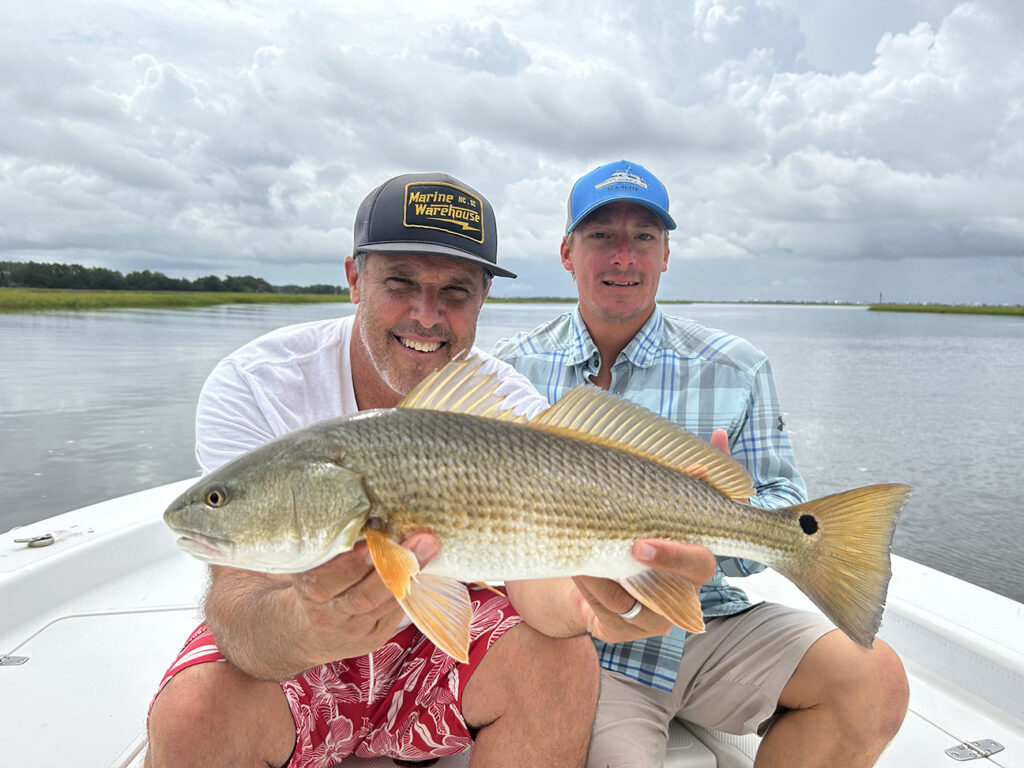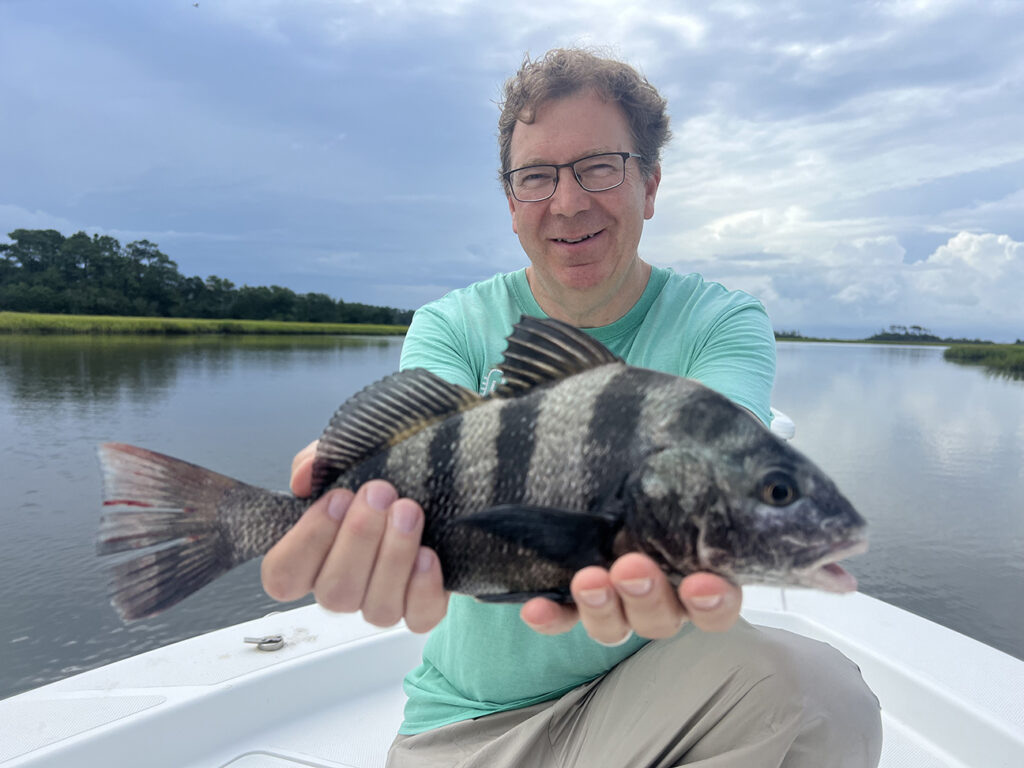Tidelines – August 2024
One benefit of bringing back the Fisherman’s Post Saltwater Podcast Series is the opportunity to talk fishing with old and new friends in the NC saltwater fishing community, and apparently a benefit for my new co-host David Hardin is that these old and new friends are generous in inviting David to fish for the species that we talk about when filming.
Such was the case with Capt. Steve Von Voigt, of Reel Em Up Charters out of the Southport/Oak Island area. At the end of shooting Steve’s podcast on Summertime Black Drum Fishing, David mentioned that he had never caught a black drum.
Was David trolling for an invite? Was my mild-mannered podcast buddy a master manipulator? Perhaps, but since Steve was kind enough to invite both of us, I figured what’s the harm in graciously accepting Steve’s kindness.
Dave and I met Steve at the “A” dock of Morningstar Marinas Southport, the finger dock closest to the boat ramp, hopped on his 25’ Blackjack powered by a 300 Yamaha, and idled out into the ICW at around 7:00 am. Steve’s original plan was to head west out of the marina, but as it goes with summer fishing, storms and the threat of storms were all around, but they were looking especially ominous to the west.
“I’m thinking we should head behind Bald Head,” Steve announced, as we all checked the radar apps on our phones to get a mutual feel for the direction those western, dark clouds were headed.

Gary Hurley (left), of Fisherman’s Post, with one of the redfish that hit a live mud minnow in water muddied by two days of drenching rains. He was fishing a grass line in a creek with Capt. Steve Von Voigt (right), of Reel Em Up Charters out of Southport.
Steve wasn’t looking at an easy day of getting David on a black drum, as there were obstacles all around. Heavy rain was moving in, and the area had experienced frequent and continuous rain in the days before our trip, making the water dirty (dirtier) and adding the unpredictable variant of a new and changing freshwater to saltwater ratios.
In addition, we had a rising tide (Steve prefers the fall) and needed to find our fish before water levels got too high and the black drum would move out of the deeper holes and spread out.
However, the rainwater also brought a benefit—water temps had been in the 90s, but the rain had dropped them down to the low 80s and that would hopefully get fish active.
“I like to bring a variety of bait, especially after a rain,” he continued when we slowed for the last No Wake zone before crossing the river. “We have shrimp with heads on, mud minnows, and mullet minnows. I really like the mud minnows after a rain. They stay alive better in the brackish and fresh rainwater, and fish just seem to respond better to them following a storm.”
Our first spot was a long grass line with a long bank lined with oyster rocks that dropped off into a muddy bottom. Steve had us throw out a spread of mud minnows and shrimp, and it was no surprise that the shrimp drew attention first. The quick bites were from “undesirables,” but Steve didn’t mind.
As he pulled a croaker off of David’s hook, Steve explained, “I like to give away some shrimp to get the bite started. Stir up the area with shrimp by bringing in the little ones, and then the bigger ones typically follow the little ones.”
We gave away shrimp and mud minnows, with one of the minnows finding a 20” flounder, but then rain chased us to the Fish Camp where we sat out the front with a fellow guide that had been on the water prepping for an afternoon trip.
Four radar apps on four phones means that everyone sees something different, but soon enough the rain had dissipated and structures on the western horizon were visible again, so we put the Blackjack to 45 mph and headed to a Southport creek where Steve had originally wanted to start our day.
With black drum as our target species, our first stop in the creek was a big flat next to a couple of deep holes. Steve typically likes to fish this spot on a falling tide, targeting the drop-off zone to get the fish as they’re coming off the flat, but he changes strategy on the rising tide to focus more on the deeper part of the holes further away from the flat and the drop-off.

David Hardin, co-host of the Fisherman’s Post podcast, with his first black drum. The fish hit a whole shrimp in a deep hole in a Southport-area creek. He was fishing with Capt. Steve Von Voigt, of Reel Em Up Charters.
David and I were armed with whole shrimp, and Steve hooked the shrimp bent in a way to give the illusion that they were swimming. David cast into a 14’ hole just a few feet off a grass bank, and I threw my shrimp to where Steve said the flat started dropping down into another hole.
Less than ten minutes later, David was pulling his first black drum into Steve’s waiting landing net. David posed for confirmation photos, and all three of us celebrated the accomplishment.
We continued to play with the black drum, and then Steve suggested we try for some red drum before the tide got any higher and the red drum would be harder to target.
For redfish, we moved up closer to the creek mouth, focusing on a grass line that had a deep drop with a muddy bank down to a shelly bottom.
“This is a red drum zone,” he told us as he armed each of us with a mud minnow. “The red drum are coming in with the tide and riding the bank, and they favor those deeper drops with oyster beds.”
Again, in less than ten minutes, David’s rod bent over and drag began peeling off, and then a little more than ten minutes later, my mud minnow must have landed immediately in front of a redfish. The hookup was immediate.
Back at Morningstar Marinas Southport, Steve was cleaning our fish, a service he does for all of his clients, and we recounted the species tally: flounder, black drum, red drum, whiting, croakers, and bluefish, as well as the less celebrated small sharks and rays. We had checked black drum off of David’s list of fish he hadn’t caught and spent the rest of our time together landing the variety that shrimp (and mud minnows and mullet minnows) makes possible
Capt. Steve Von Voigt, of Rell Em Up Charters, will be primarily targeting redfish in August, a Southport bite that really cranks up in August, but black drum, flounder, and other opportunities are always present.
You can find out more about Steve by visiting Reel Em Up Charters on Facebook and Instagram, or you can call him directly at (910) 352-1030.
Tell him what species you’d like to catch, and maybe use the same puppy dog eyes that David shamelessly made.
And while I’m sure Steve will be armed with a variety of bait, it couldn’t hurt to ask at the dock if he has a dip net on board.
